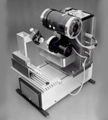Since this saw uses a diamond-coated wire to cut, it will cut through ANYTHING. Several unique design features combine to allow thin sections down to 30 microns to be cut in the cool, gentle fashion necessary to preserve the microstructure of your samples and materials.
HISTO SAW
 A range of models and accessories is available to satisfy the widest range of laboratory applications. These saws offer cost effective conistent sectioning. Increase productivity by eliminating the need for handgrinding.
A range of models and accessories is available to satisfy the widest range of laboratory applications. These saws offer cost effective conistent sectioning. Increase productivity by eliminating the need for handgrinding.
The Histo Saw was designed for biological and materials research labs. For preparing section for auto/micro radiography, and implants including dental and routine sectioning of undecalcified bone
HISTO SAW ACCESSORIES
The model 3241 Diamond Wire Saw comes with:
| Micrometer Table | Transformer for 115V |
| Drum With 10m of Wire | Rewinding Attachment |
| Replacement Spool of 120m of Wire | Bottle of Cleansing Concentrate |
| Sample Holder | Spare Drum |
Two options are available for replenishing spent diamond wire. You can return the used spools to DDK for refurbishing. We completely clean the spools, replace damaged or missing hardware and replace the 10m of diamond wire. You can purchase a special rewinding tool for easily and properly replacing diamond wire on your own spools.
A wide range of custom sample holders have been made to firmly and precisely orient samples with the cutting wire. Ranging from simple vises to three-axis goniometer heads, DDK can affordably design and build holders to suit your specific samples whether they be plastic embedments, native bone, crystals, lenses, minerals, metals … you name it!
Of course, DDK keeps a stock of spare parts should you have problems with your Histo-Saw down the road. Pulleys, spools, fuses, bearings, switches, bulbs … just about anything can be provided quickly. Service work you can’t do yourself is performed quickly in our shop with turnaround limited to little more than the shipping time between you and DDK. Easily cuts through a variety of densities
UNIQUE FEATURES
1. The diamond wire is a single strand fastened at each end so there is no weld to be a weak point or cause rough surfaces. The wire stays vertical throughout its reciprocating motion because the pitch of the thread that holds the wire on the spool is the same as the motor’s lead screw pitch. Reversing switches change the direction of the motor’s rotation creating the reciprocating motion.
2. The wire is made with a high tensile strength stainless steel core that is plated with copper. Finely graded diamond abrasive particles are then mechanical pressed into the copper. Two coats of nickel are electroplated over all to firmly bind the diamond to the wire. This diamond wire will cut anything with its life determined by the hardness and size of the sample.
3. Diamond saws generally feed the sample through the cutting blade by gravity. Most saws use a pivoting motion, however, resulting in a cutting force that varies with the position of the sample … low when the sample is high above the blade’s centerline and high at the end of the cut when the sample arm is parallel to the ground. The Histo-Saw uses a set of linear ways or bearings down which the wire and motor coast during the cut. The cutting force stays constant and is determined by how much slope you dial into the instrument.
4. Through a combination of slow speed and coolant use, the Histo-Saw cuts with a minimum of heat generation and sample damage. You can be confident that this saw will not add any unintentional damage, mechanical or chemical, to your sample. If the sample is water- sensitive, use an oil for cooling the sample and flushing away the swarf. Microscopic examination of thin sections has shown the Histo-Saw to be an excellent tool for study of microstructure and microdamage in a variety of materials.
5. The Histo-Saw lends itself well to unattended operation through the use of sensors to detect end-of-cut and broken wire situations. The saw is then shut down until an attendant restarts the instrument.
6. By mounting your samples on a micrometer with 10 micron resolution, it is possible to position each cut precisely for sectioning or accurate parting of samples. Micrometer accessories are also available for controlling depth of cut when creating slots or indents in materials testing or production applications.
